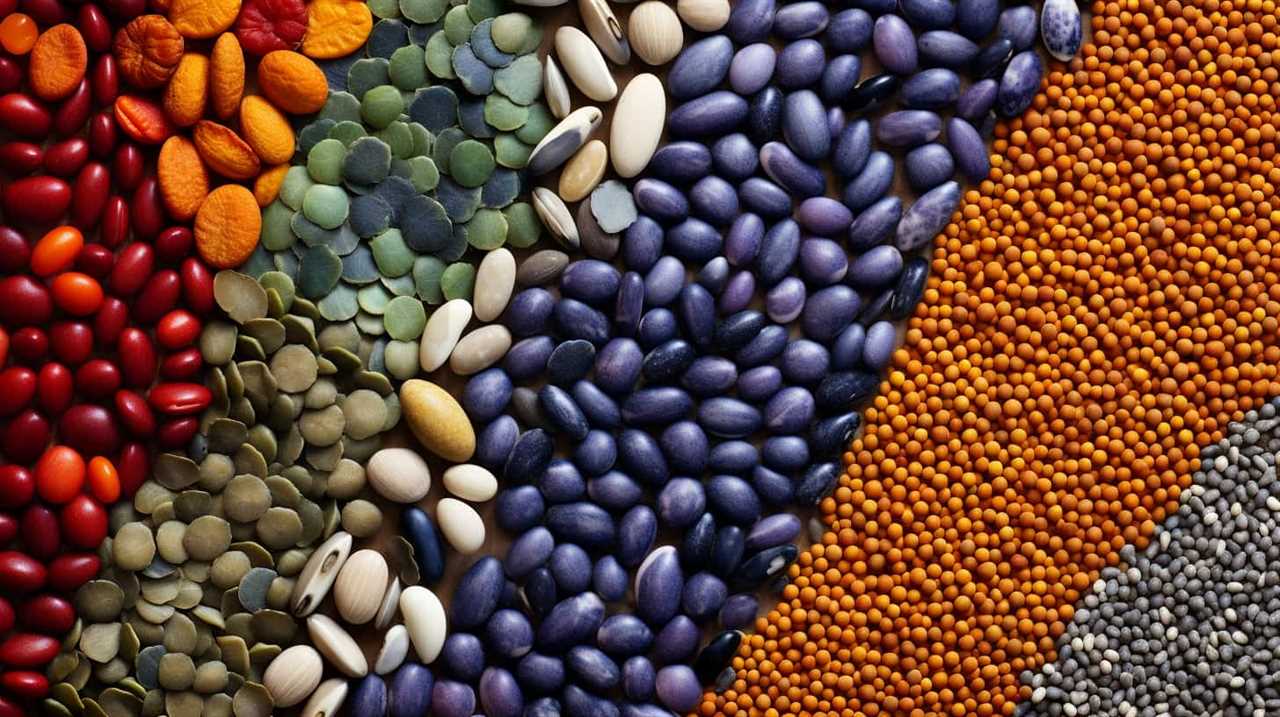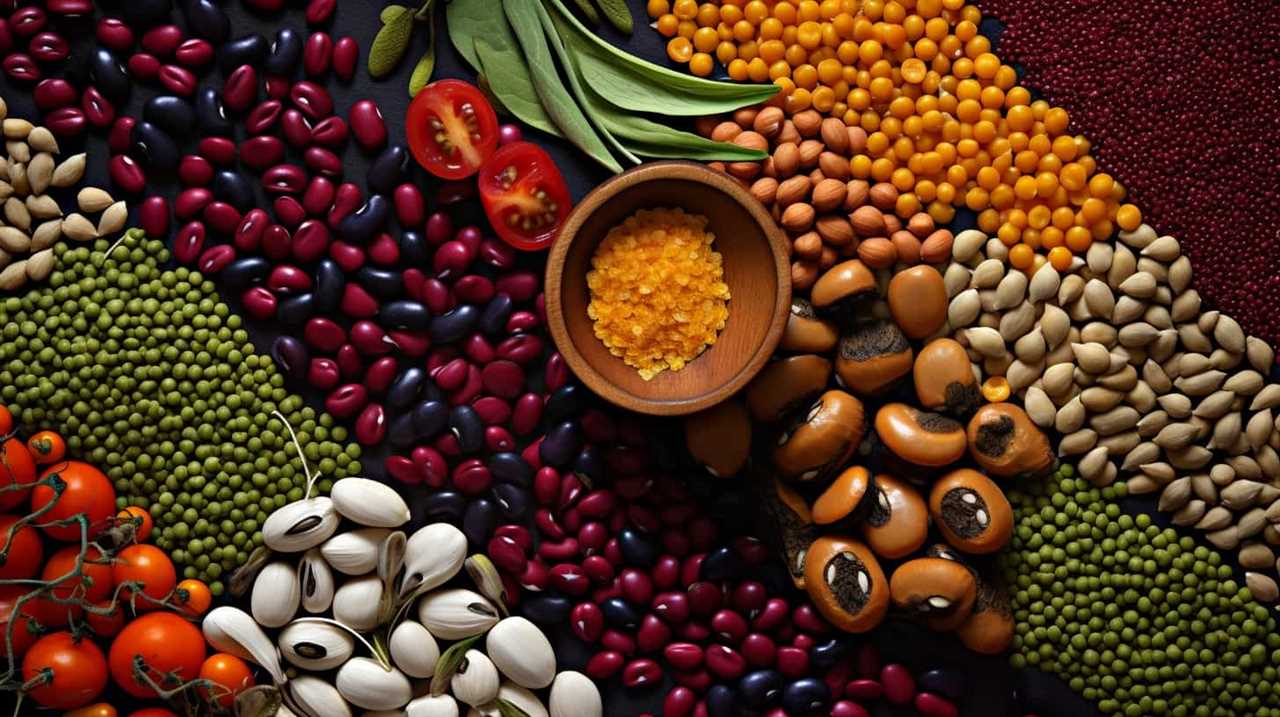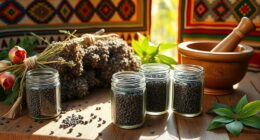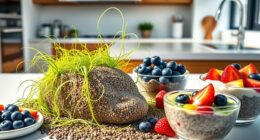We have gathered 11 recommendations for incorporating super seeds into your gluten-free cooking recipes to support our dedication in offering you helpful, research-backed advice.
These tiny powerhouses, like chia seeds, offer numerous benefits for those following a gluten-free diet.
From boosting fiber content to acting as a natural egg replacer, these tips will help you unlock the full potential of super seeds in your cooking.
Get ready to elevate your gluten-free recipes and nourish your body with these nutritious additions!
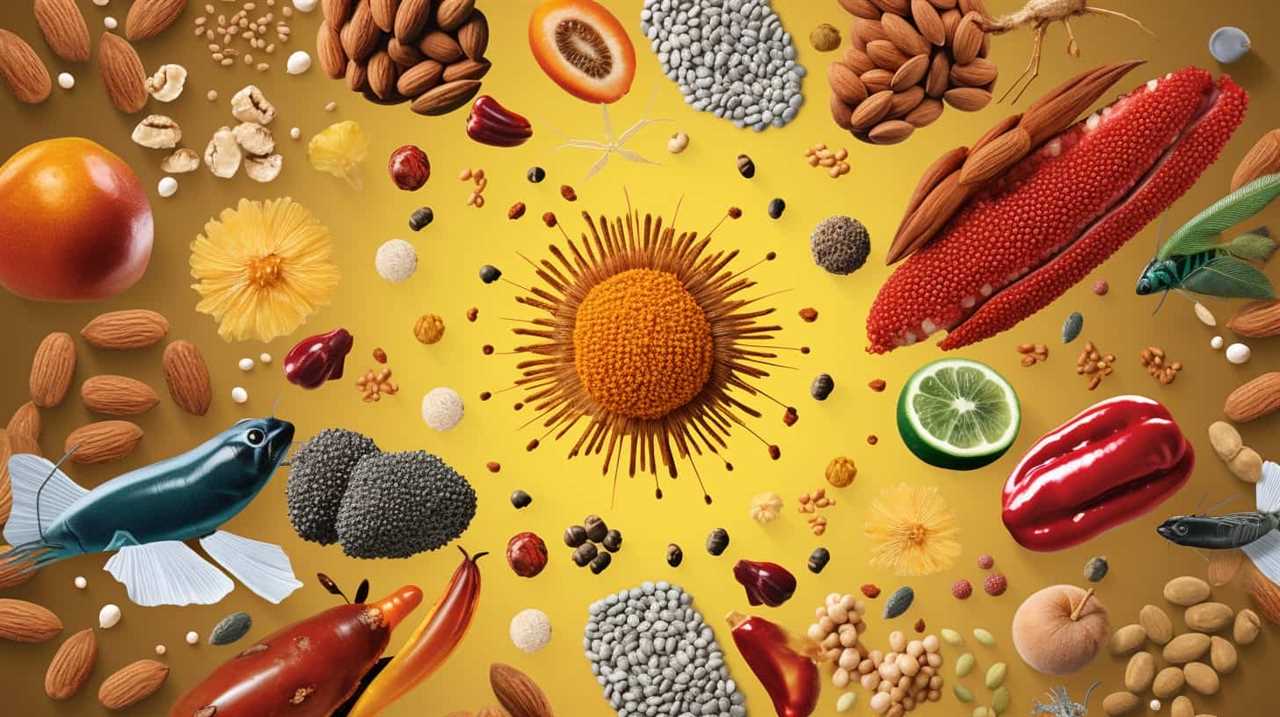
Key Takeaways
- Chia seeds are a beneficial addition to gluten-free diets due to their high fiber content and omega-3 fatty acids.
- Chia seeds can be used as a natural egg replacer in vegan baking, creating a gel-like consistency that adds structure and moisture to recipes.
- Adding chia seeds to recipes such as salad dressings, smoothies, and oatmeal increases the fiber content and adds texture.
- Chia seeds can act as a thickening agent in soups, sauces, and desserts, providing versatility and enhancing the texture of gluten-free recipes.
Benefits of Chia Seeds in Gluten-Free Diets
One of the top three benefits of incorporating chia seeds in our gluten-free diets is their high fiber content. Chia seeds are an excellent source of dietary fiber, with just one ounce of chia seeds providing a whopping 10 grams of fiber. This is great news for those following a gluten-free diet, as fiber helps regulate digestion and can prevent constipation, a common issue for people with celiac disease or gluten sensitivity.
Additionally, chia seeds are a fantastic source of omega-3 fatty acids, which are essential for brain health and reducing inflammation. These tiny seeds are also a popular ingredient in vegan baking, as they can be used as an egg substitute due to their ability to absorb liquid and create a gel-like consistency.
Incorporating chia seeds into your gluten-free diet not only adds nutritional value but also enhances the taste and texture of your favorite recipes.
How to Choose and Store Chia Seeds
When incorporating chia seeds into our gluten-free diets, it’s important to know how to choose and store them properly. Here are some tips to help you make the best choices and ensure that your chia seeds stay fresh and nutritious:

- Choosing organic chia seeds: Look for organic options to avoid exposure to harmful pesticides and chemicals. Organic chia seeds are grown without synthetic fertilizers or pesticides, making them a healthier choice for you and the environment.
- Properly soaking chia seeds: Soaking chia seeds before consuming them can help enhance their nutritional benefits. To soak chia seeds, simply mix them with water or any liquid of your choice and let them sit for about 15 minutes. This helps them absorb the liquid and become gel-like, making them easier to digest.
- Storage: Store your chia seeds in an airtight container in a cool, dry place. This will help prevent them from becoming rancid or losing their nutritional value. Avoid exposing them to heat, moisture, or direct sunlight.
- Expiration date: Check the expiration date on the package before buying chia seeds. Using them before they expire ensures that you get the maximum nutritional benefits.
- Quality: Choose chia seeds that are clean, dry, and free from any signs of mold or moisture. This ensures that you’re getting high-quality seeds that are safe to consume.
Chia Seeds as a Natural Egg Replacer
We love using chia seeds as a natural egg replacer in our gluten-free recipes. Chia seeds aren’t only a great source of nutrients, but they also work as a binding agent, making them an excellent substitute for eggs in vegan baking.
When mixed with water, chia seeds form a gel-like consistency that helps bind the ingredients together, providing structure and moisture to the finished product. To replace one egg, simply combine 1 tablespoon of chia seeds with 3 tablespoons of water and let it sit for about 15 minutes until it thickens.
This chia seed gel can then be used in recipes such as cakes, cookies, and muffins.
Boosting Fiber Content With Chia Seeds
How can chia seeds be used to boost the fiber content in our gluten-free recipes?
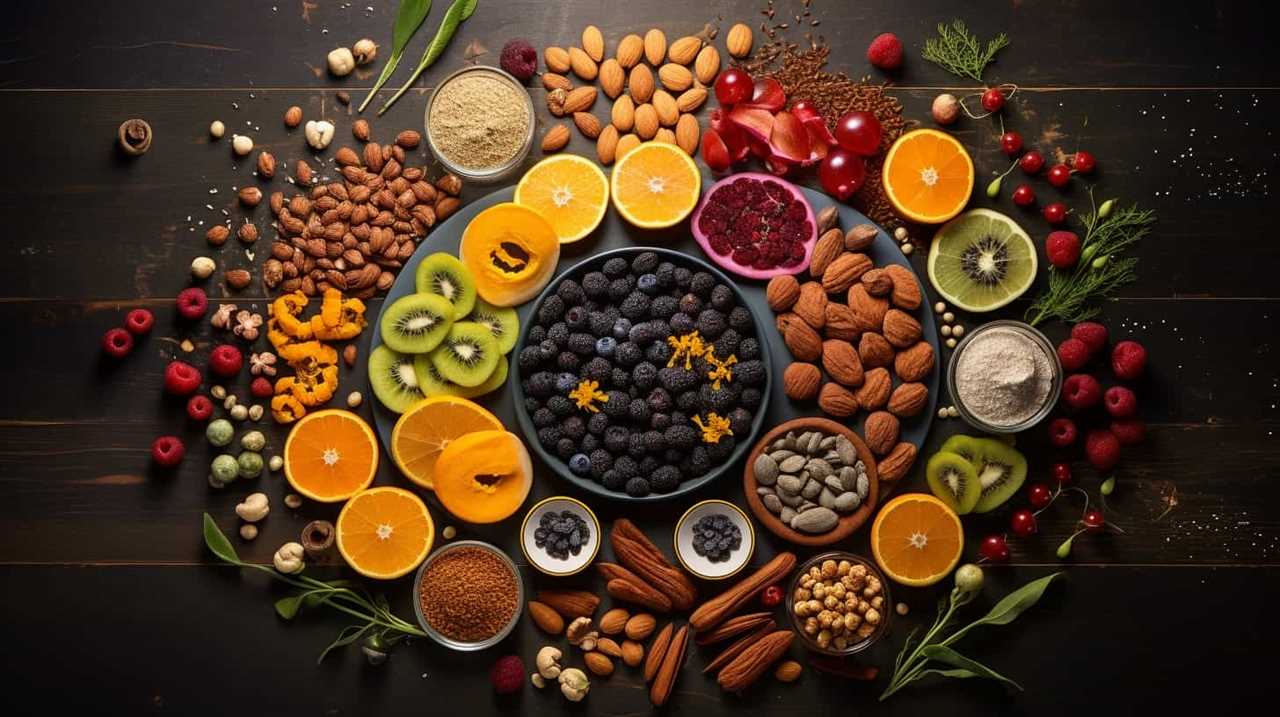
Chia seeds are a versatile ingredient that can easily be incorporated into a variety of dishes to increase their fiber content. Here are some practical ways to use chia seeds in your gluten-free recipes:
- Add chia seeds to salad dressings: By blending chia seeds with your favorite salad dressing ingredients, you can create a delicious and fiber-rich dressing that adds a nutritional boost to your salads.
- Use chia seeds in vegan recipes: Chia seeds can be used as a binding agent in vegan recipes, such as replacing eggs in baking. This not only adds fiber but also provides a healthier alternative to animal products.
- Mix chia seeds into smoothies: Adding chia seeds to your smoothies not only boosts their fiber content but also adds a nice texture and a subtle nutty flavor.
- Sprinkle chia seeds on top of oatmeal or yogurt: This simple addition can significantly increase the fiber content of your breakfast or snack.
- Make chia seed pudding: Chia seeds can absorb liquid and create a pudding-like consistency when mixed with a liquid like almond milk. This makes for a tasty and fiber-packed dessert or breakfast option.
Chia Seeds as a Thickening Agent
One way to utilize chia seeds in gluten-free recipes is by using them as a thickening agent. Chia seeds have a unique ability to absorb liquid and form a gel-like consistency, making them perfect for thickening soups and sauces. Simply sprinkle a tablespoon or two of chia seeds into your soup or sauce while it’s simmering, and watch as they thicken it up to the perfect consistency.
Another great way to incorporate chia seeds as a thickening agent is by adding them to salad dressings. Instead of using traditional thickeners like cornstarch or flour, try whisking in a tablespoon of chia seeds. Not only will they help thicken the dressing, but they’ll also add a boost of nutrition with their omega-3 fatty acids and fiber content.
To summarize, chia seeds can be a versatile and healthy option for thickening soups and salad dressings. Give them a try in your next recipe and enjoy the added nutritional benefits they provide.

| Pros | Cons |
|---|---|
| – Natural thickening agent | – May alter the texture of the dish |
| – Adds nutritional value | – Requires additional stirring to prevent clumping |
| – Gluten-free alternative | – May not work well in all recipes |
Incorporating Chia Seeds in Baked Goods
Let’s explore how to incorporate chia seeds in baked goods for added nutrition and texture. Chia seeds are a versatile ingredient that can be used in various gluten-free recipes, including baked goods. Here are some practical ways to incorporate chia seeds in your baking:
- Add chia seeds to muffins or bread dough for a crunchy texture and a boost of fiber.
- Use chia gel (made by soaking chia seeds in water) as an egg substitute in recipes that call for eggs.
- Sprinkle chia seeds on top of cookies or bars before baking for a delightful crunch.
- Make chia seed crackers by combining chia seeds, water, and gluten-free flour. Roll out the dough, cut into desired shapes, and bake until crispy.
- Blend chia seeds into your favorite gluten-free flour blend for a nutrient-packed flour alternative.
Chia seeds can also be used in salad dressings, adding a thickening and binding effect. Experiment with these ideas to elevate your baked goods with the nutritional benefits of chia seeds.
Chia Seeds in Smoothies and Beverages
When it comes to adding chia seeds to smoothies and beverages, there are two key benefits: hydration and energy.
Chia seeds are known for their ability to absorb liquid, making them an excellent addition to drinks for staying hydrated.
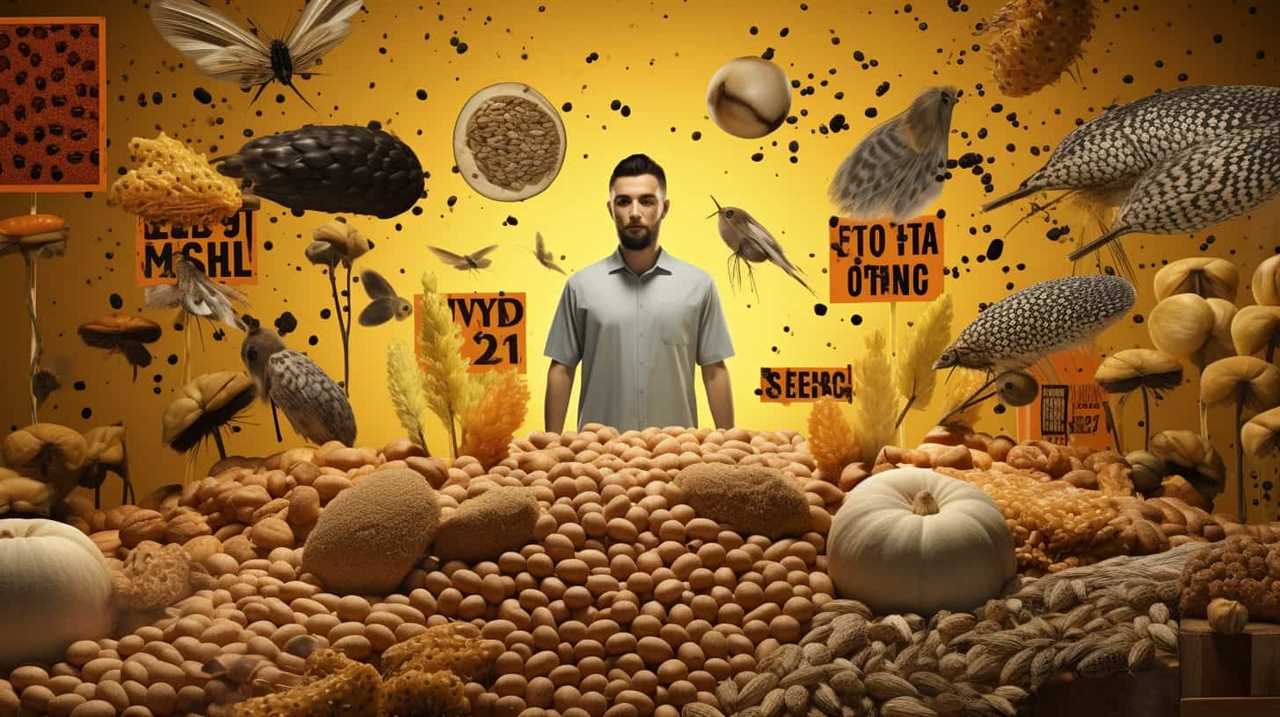
Additionally, these tiny seeds are packed with nutrients like fiber and omega-3 fatty acids, which can provide a natural energy boost.
Chia Seeds for Hydration
We love incorporating a handful of chia seeds into our smoothies and beverages for an extra boost of hydration. Chia seeds aren’t only packed with essential nutrients, but they also have the ability to absorb liquid and create a gel-like substance, which helps to keep us hydrated throughout the day.
Here are a few reasons why chia seeds are great for hydration:
- Rich in electrolytes: Chia seeds contain important electrolytes like potassium, magnesium, and calcium, which are essential for maintaining proper hydration levels.
- High water absorption: Chia seeds can absorb up to 10 times their weight in water, helping to keep us hydrated for longer periods.
- Slow release of hydration: The gel-like consistency created by chia seeds allows for a slow release of hydration, keeping us energized and hydrated throughout the day.
- Promote weight loss: Chia seeds can help with weight loss by promoting a feeling of fullness, which can prevent overeating and aid in maintaining a healthy weight.
- Beneficial for skincare: Chia seeds are rich in antioxidants and omega-3 fatty acids, which can help nourish and hydrate the skin from within.
Chia Seeds for Energy
Continuing from our previous discussion on the benefits of chia seeds, incorporating a handful of these super seeds into our smoothies and beverages provides an energizing boost. Chia seeds are not only packed with nutrients, but they also contain a good amount of healthy fats, fiber, and protein. These properties help to sustain energy levels throughout the day, making them an excellent addition to our diet.

One way to incorporate chia seeds into our drinks is by adding them to smoothies. They blend well and add a slight crunch, enhancing both the texture and nutritional value. Additionally, chia seeds can also be used in homemade beverages, such as chia seed lemonade or infused water.
Here is a table highlighting the benefits of chia seeds in smoothies and beverages:
| Benefits of Chia Seeds in Smoothies and Beverages |
|---|
| Provides sustained energy throughout the day |
| Adds nutritional value to drinks |
| Enhances texture and flavor |
| Supports weight loss |
| Can be used in various beverage recipes |
Moreover, chia seeds can even be incorporated into salad dressings, providing a healthy twist to our favorite greens. So, whether it’s a refreshing smoothie or a revitalizing beverage, chia seeds are a great addition to boost our energy levels and add nutritional value to our diet.
Chia Seeds in Breakfast Recipes
Let’s explore some delicious ways to incorporate chia seeds into your breakfast routine.

One option is to make chia pudding variations by combining chia seeds with your choice of milk, sweetener, and flavorings like vanilla or cocoa powder.
Another idea is to blend chia seeds into smoothies for an extra boost of fiber and omega-3 fatty acids.
Lastly, you can create chia overnight oats by mixing chia seeds with oats, milk, and your favorite toppings for a nutritious and convenient meal.
Chia Pudding Variations
For a delicious and nutritious breakfast option, try incorporating chia seeds into your morning routine with these chia pudding variations. Chia seed pudding recipes aren’t only easy to make but also packed with fiber, protein, and healthy fats.
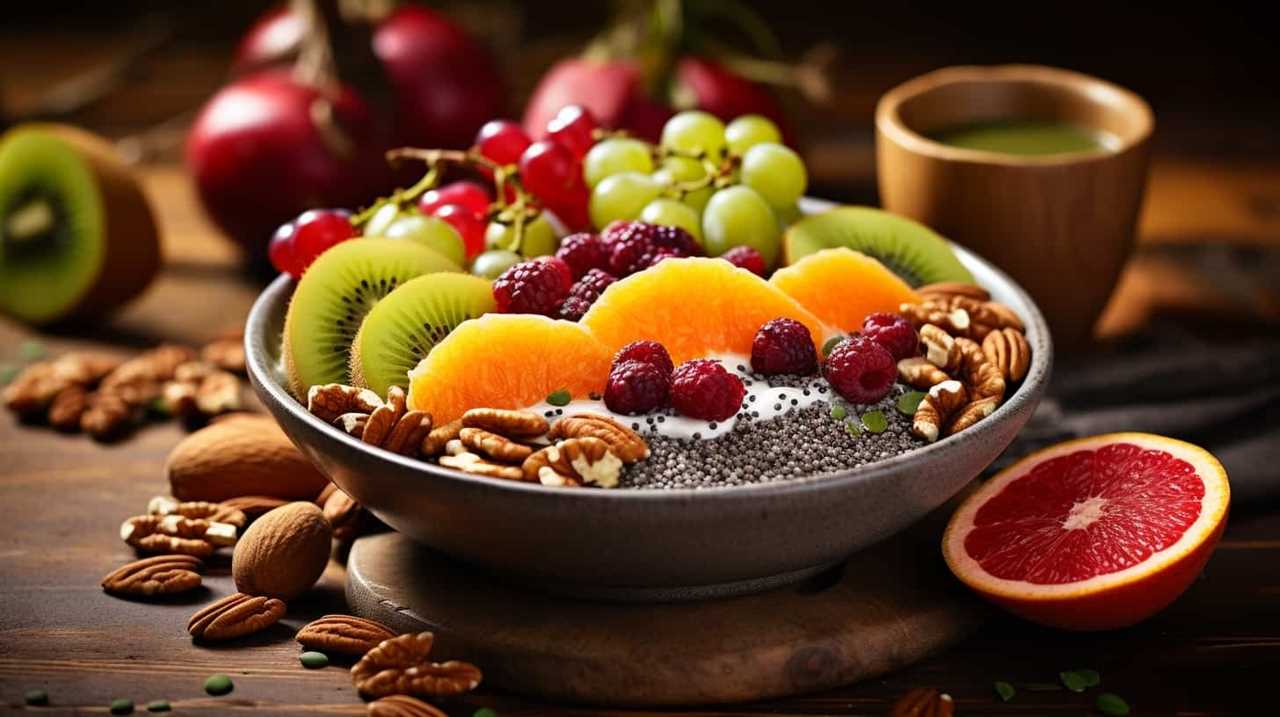
Here are five chia pudding variations to try:
- Vanilla Chia Pudding with Fresh Berries: Mix chia seeds with almond milk, vanilla extract, and a sweetener of your choice. Top it off with fresh berries for a burst of flavor.
- Chocolate Chia Pudding with Almonds: Combine chia seeds, cocoa powder, almond milk, and a touch of sweetener. Sprinkle with chopped almonds for added crunch.
- Matcha Chia Pudding with Coconut Flakes: Whisk together chia seeds, matcha powder, coconut milk, and a sweetener. Garnish with coconut flakes for a tropical twist.
- Peanut Butter Banana Chia Pudding: Blend chia seeds, almond milk, peanut butter, and a ripe banana. Serve with sliced bananas on top for extra creaminess.
- Mango Turmeric Chia Pudding: Mix chia seeds, turmeric powder, mango puree, and coconut milk. Add diced mango for a tropical kick.
These chia pudding variations aren’t only delicious but also provide a nutritious start to your day. Experiment with different flavors and toppings to find your favorite combination.
Chia Seed Smoothies
To continue incorporating chia seeds into our breakfast routine, we can explore the delicious and nutritious option of chia seed smoothies. Chia seeds are a great addition to smoothies as they provide a boost of fiber, protein, and omega-3 fatty acids. They also help to thicken the smoothie and create a creamy texture.
Here is a simple recipe to get you started:

| Ingredients | Instructions |
|---|---|
| 1 cup of almond milk | 1. In a blender, combine all ingredients and blend until smooth. |
| 2 tablespoons of chia seeds | 2. Pour into a glass and let it sit for 10-15 minutes to allow the chia seeds to thicken. |
| 1 ripe banana | 3. Stir well before drinking to evenly distribute the chia seeds. |
| 1 tablespoon of honey | |
| 1 cup of frozen berries |
Feel free to experiment with different fruits, such as mango or pineapple, and add a handful of spinach or kale for an extra nutritional boost. Chia seed smoothies are a quick and easy way to incorporate these super seeds into your breakfast routine.
Keywords: chia seed pudding recipes, chia seed energy bars.
Chia Overnight Oats
Incorporating chia seeds into our breakfast routine, we can enjoy the delicious and nutritious option of chia overnight oats. Chia seeds aren’t only a great source of fiber and omega-3 fatty acids, but they can also aid in weight loss. Here are five reasons why you should try chia overnight oats:
- Chia seeds are a rich source of protein, helping to keep you feeling full and satisfied throughout the morning.
- The high fiber content of chia seeds can promote healthy digestion and prevent overeating.
- Chia seeds have been shown to help regulate blood sugar levels, making them a suitable option for those with diabetes or insulin resistance.
- The omega-3 fatty acids found in chia seeds have anti-inflammatory properties, which can support overall health and wellbeing.
- Chia overnight oats are easy to prepare and can be customized with your favorite toppings and flavors.
Now that we’ve seen the benefits of incorporating chia seeds into our breakfast, let’s dive into how chia seeds are a nutritional powerhouse in other aspects of our diet.
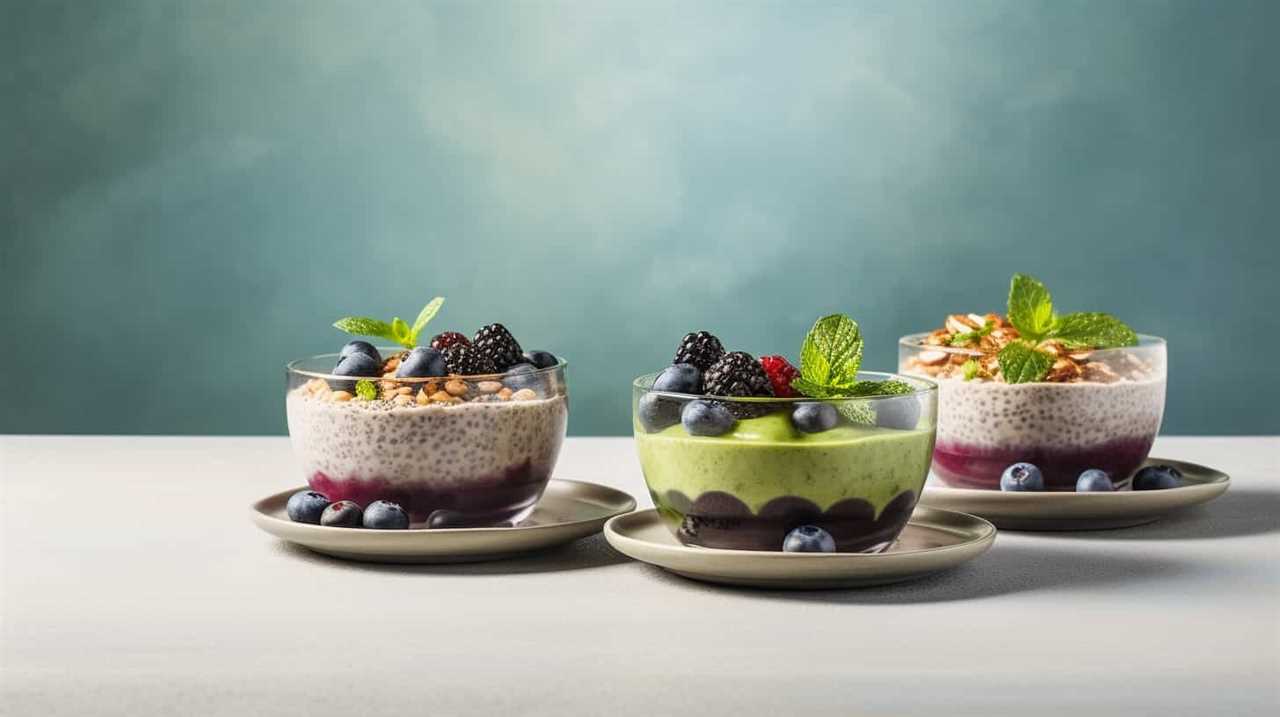
Chia Seeds as a Nutritional Powerhouse
We love using chia seeds as a nutritional powerhouse in our gluten-free recipes. Not only do chia seeds add a delightful crunch and texture, but they also offer numerous health benefits. Chia seeds are rich in fiber, protein, and omega-3 fatty acids, making them a great addition to any diet.
For those looking to lose weight, chia seeds can be a helpful tool. The high fiber content of chia seeds can help you feel fuller for longer, reducing the urge to snack between meals.
Additionally, chia seeds are a wonderful option for those following a vegan diet. They provide essential nutrients like calcium and iron, which can sometimes be lacking in plant-based diets.
Chia Seeds in Savory Dishes
When it comes to incorporating chia seeds into savory dishes, there are several points to consider.
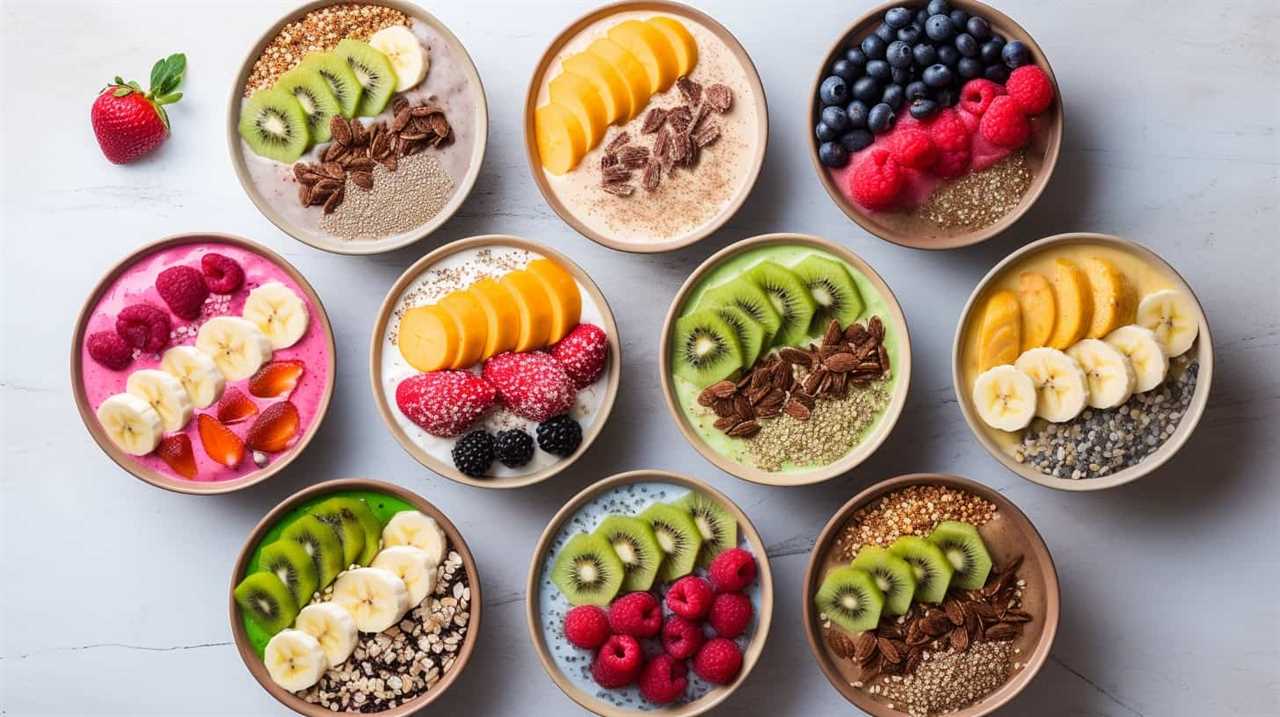
Firstly, chia seeds can act as a flavor enhancer, adding a subtle nutty taste to your meals.
Secondly, they can be used as a main ingredient in dishes like chia seed burgers or chia seed-crusted chicken.
Lastly, chia seeds can provide added texture to savory dishes, whether it’s sprinkled on top of a salad or mixed into a soup or stew.
Chia as Flavor Enhancer
Chia seeds can add a burst of flavor to savory dishes, enhancing their taste and nutritional value. Here are some practical ways to incorporate chia seeds as a flavor enhancer in your favorite savory recipes:

- Sprinkle chia seeds as a salad topping: Add a crunchy texture and nutty flavor to your salads by simply sprinkling chia seeds over the greens. They’ll not only elevate the taste but also provide an extra dose of fiber and omega-3 fatty acids.
- Blend chia seeds into salad dressings: For a creamy and nutritious salad dressing, blend chia seeds with olive oil, vinegar, herbs, and spices. The chia seeds will help thicken the dressing while adding a subtle nuttiness.
- Mix chia seeds into savory sauces: Whether it’s a marinara sauce or a homemade barbecue sauce, mixing chia seeds into the recipe can enhance the flavor and provide a nutrient boost. The chia seeds will absorb some of the liquid, creating a thicker and more flavorful sauce.
- Add chia seeds to savory baked goods: Incorporate chia seeds into your favorite savory baked goods like bread, crackers, or muffins. They can add a unique texture and a mild, nutty flavor to your creations.
- Use chia seeds as a meat or vegetable binder: Chia seeds can act as a binder in recipes that require meat or vegetable patties. They help hold the ingredients together while adding a subtle taste and nutritional benefits.
Chia in Main Courses
Incorporating chia seeds into main courses can elevate the flavor and nutritional profile of your savory dishes. Chia seeds aren’t limited to being used in desserts or smoothies; they can add a crunchy texture and nutty flavor to your salads and other main course recipes.
For a simple and nutritious salad, sprinkle chia seeds over a bed of mixed greens and top with your favorite vegetables and protein. You can also create chia-infused dressings by blending chia seeds with olive oil, lemon juice, garlic, and herbs. The chia seeds will thicken the dressing, giving it a creamy consistency.
These chia-infused dressings can be drizzled over grilled chicken, roasted vegetables, or even used as a dip for raw veggies. By incorporating chia seeds into your main courses, you can enhance both the taste and nutritional value of your meals.
Chia for Added Texture
To continue enhancing the flavor and nutritional value of our savory dishes, let’s explore how chia seeds can be used to add texture and depth to our gluten-free recipes. Chia seeds aren’t only packed with essential nutrients, but they also offer a delightful crunch that can elevate any dish.

Here are some ways you can incorporate chia seeds to add texture:
- Sprinkle chia seeds on top of salads for a satisfying crunch and added fiber.
- Mix chia seeds into salad dressings for a thicker consistency and a boost of omega-3 fatty acids.
- Use chia seeds in breading for a gluten-free alternative that adds a crispy texture to meat and vegetables.
- Blend chia seeds into soups or stews to thicken the broth and create a heartier texture.
- Incorporate chia seeds into homemade veggie burgers or meatballs to add texture and bind the ingredients together.
Now that we’ve explored how chia seeds can enhance our savory dishes, let’s move on to the next section and discover how chia seeds can be a healthy snacking option.
Chia Seeds for Healthy Snacking Options
For those seeking healthy snacking options, incorporating chia seeds into gluten-free recipes can provide numerous benefits.
Chia seeds are packed with essential nutrients like fiber, protein, and omega-3 fatty acids, making them a perfect choice for guilt-free snacking.

These tiny seeds are also known to aid in weight loss due to their ability to absorb liquid and expand in the stomach, helping to promote a feeling of fullness.
Additionally, chia seeds can be sprinkled on top of salads or used in salad dressings to add a crunchy texture and boost the nutritional value of your meal.
Frequently Asked Questions
Are Chia Seeds Safe for People With Nut Allergies?
Chia seeds are safe for people with nut allergies as they are not nuts. However, cross contamination risks may exist. Chia seeds provide nutritional benefits for individuals with nut allergies, such as omega-3 fatty acids and fiber.
Can Chia Seeds Be Used as a Substitute for Other Types of Seeds?
Yes, chia seeds can be used as a substitute for other types of seeds. They have many benefits, such as being a great egg substitute and adding nutritional value to smoothies.
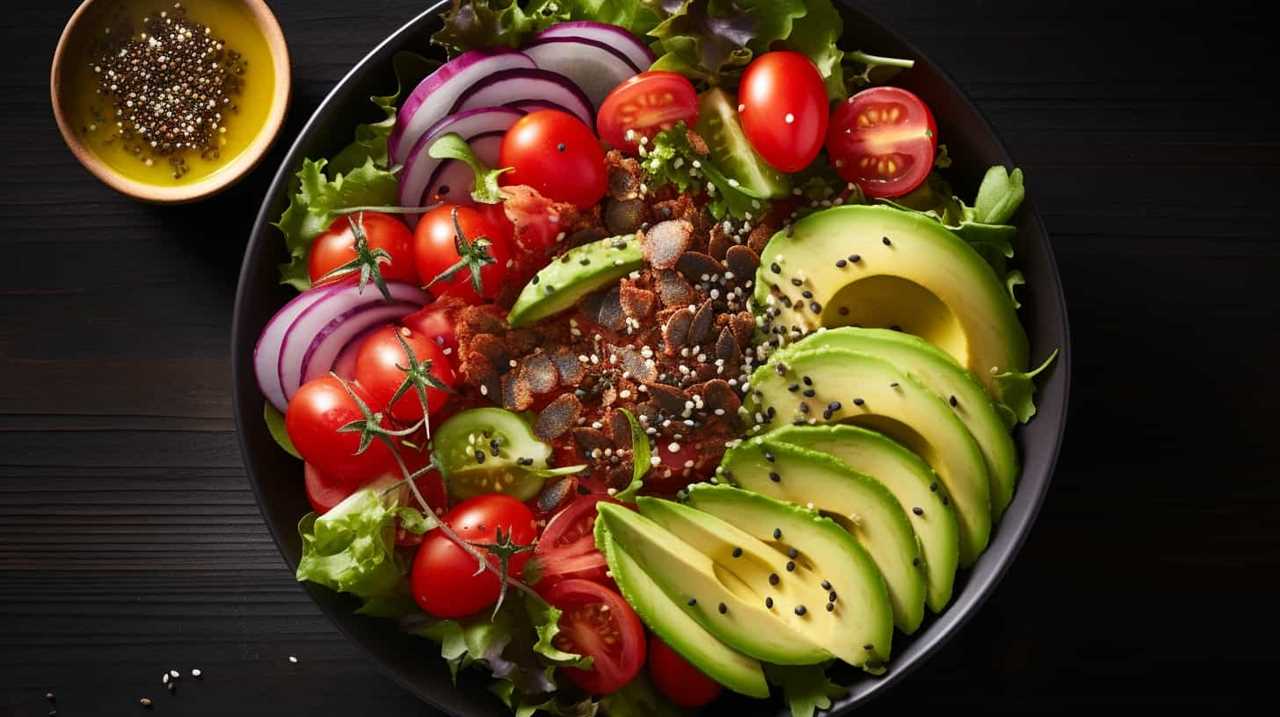
How Can Chia Seeds Be Incorporated Into Gluten-Free Pasta Recipes?
We can incorporate chia seeds into gluten-free pasta recipes by adding them to the sauce or mixing them directly into the pasta dough. Chia seeds also work well in salads and smoothies for added nutrition and texture.
Can Chia Seeds Be Used to Make Gluten-Free Bread?
Yes, chia seeds can be used to make gluten-free bread. They are a great source of fiber, omega-3 fatty acids, and antioxidants. There are many delicious chia seed bread recipes that you can try.
Are There Any Potential Side Effects or Risks Associated With Consuming Chia Seeds?
There are potential side effects of consuming chia seeds, such as digestive issues and blood pressure changes. It is important to be aware of these risks and consider them when incorporating chia seeds into your diet.
Conclusion
Incorporating super seeds like chia in your gluten-free recipes can be a game-changer for your health. These tiny powerhouses are packed with nutrients and offer a range of benefits, from boosting fiber content to serving as a natural egg replacer.
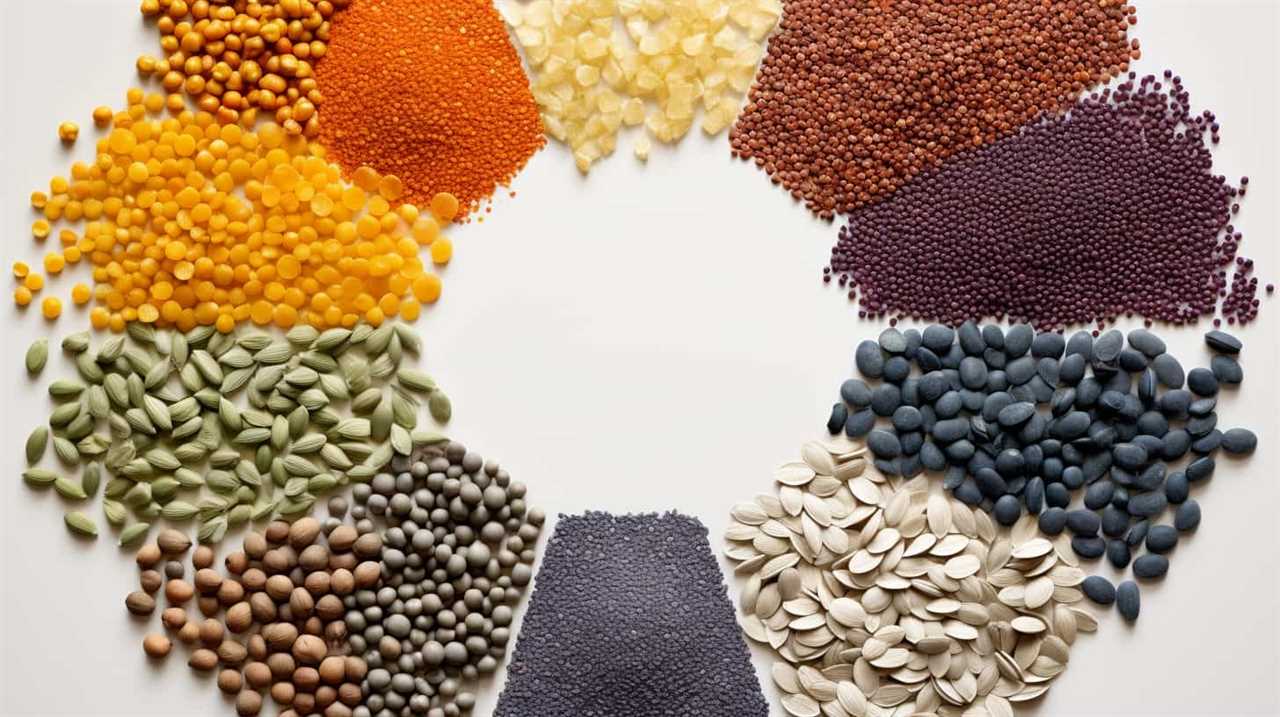
Whether you’re looking to thicken your dishes or add a nutritional punch to your meals, chia seeds are a versatile ingredient that can elevate your gluten-free cooking.
So go ahead and sprinkle some chia magic into your recipes and enjoy the delicious and nutritious results!


